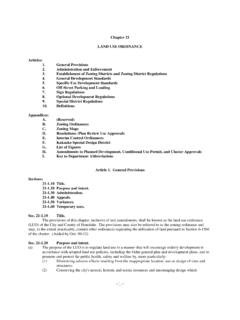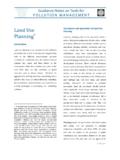Transcription of An Overview of California Land Use Planning and …
1 An Overview of California land Use Planning and Regulation (hierarchy of relationships) Police Power General Plan Specific Plan Zoning Ordinance Subdivision Ordinance Development Agreements Legislative Acts Administrative Acts Subdivision Maps, Development Permits, Conditional Use Permits, Variances, etc. by Thomas Jacobson, AICP The Police Power Planning and the regulation of land use are based upon local government's "police power." The courts have held that the police power may be used to regulate a wide and expanding variety of activities as long as it is exercised in a manner that is reasonably related to the protection of the public's health, safety, and welfare, is not preempted by federal or state law, and is within the framework of state statute.
2 Community Planning , zoning laws, subdivision regulations , rent controls, sign controls, community growth management regulations , and dedications of private land as a condition of development approval are some examples of the police power at work. Constitutional guarantees of equal protection, free speech, due process, and just compensation for the taking of private property define the boundaries of the police power. An illegal "taking" may occur as a result of either the public's acquisition of private property without just compensation or of excessively restrictive land use regulations that deprive a property owner of all uses of his/her land .
3 TYPES OF PROJECTS PROCESSED BY INYO COUNTY General Plan Amendments that affect the entire County, or entire land use designations General Plan Amendments on specific properties Zoning Ordinance changes Zoning designation changes on specific properties Specific Plan Precise Plan Conditional Use Permits Conditional Use Permit: Water Transfers Conditional Use Permit: Geothermal Plant Conditional temporary uses: 1. In any R district, a tract and sales office during the period of construction and original sale of the lots or buildings in a new subdivision; provided, that the office and accessory signs allowed by the conditions of the approval shall be removed and all the district regulations applied within ten days after the expiration of a time limitation which shall be specified in each instance; 2.
4 In any district, a directional sign, which shall consist solely of the name and location of a new tract or subdivision and directions for reaching same; provided that every such sign shall be removed within ten days after the expiration of a time limitation of one year from the date of time approval. Variance Wireless Communication Facilities Plan Design review approval for mobile homes/permits Lone Pine Architectural Review Tentative Parcel Map (four parcels) Tentative Tract Map (more than four parcels) Lot Line Adjustment/Certificate of Compliance Parcel Merger Mine Reclamation Plans and Plan Amendments (SMARA) STATE LAW AND LOCAL Planning State law is the foundation for local Planning in California .
5 The California Government Code (Sections 65000 et seq.) contains many of the laws pertaining to the regulation of land uses by local governments including: the general plan requirement, specific plans, subdivisions, and zoning. However, the State is seldom involved in local land use and development decisions; these have been delegated to the city councils and boards of supervisors of the individual cities and counties. Local decision makers adopt their own sets of land use policies and regulations based upon the state laws.
6 Hearing Bodies In counties, the board of supervisors can appoint one or more hearing bodies to assist them with Planning matters. Inyo County s hearing bodies and their responsibilities are: The Planning Commission: considers general plan and specific plan amendments, zone changes, and major subdivisions. Lone Pine: reviews projects to ensure that they meet community aesthetic standards. In Inyo County, the Planning Commission has final approval authority over conditional use permits, variances, tentative parcel and tract maps, and other more minor permits, as well as the CEQA determinations for all these actions.
7 All Planning commission final decisions may be appealed to the Board of Supervisors. Planning Commissions do not have final say on matters of policy such as zone changes and general or specific plan amendments. Hearings State law requires that local governments hold public hearings prior to most Planning actions. The method of advertising hearings may vary. Notice of a proposed general plan amendment affecting allowable land uses, zone change, conditional use permit, variance, and subdivision tract and other Planning actions are published in the newspaper and on actions for specific properties, mailed to nearby property owners.
8 There are size and substance of notice requirements, as well as minimum and maximum time periods for sending out notices prior to hearings. At the hearing, the board, or commission will explain the proposal, consider it in light of local regulations and environmental effects, and listen to testimony from interested parties. The council, board, or commission will vote on the proposal at the conclusion of the hearing. Depending upon each jurisdiction's local ordinance, public hearings are not always required for minor land subdivisions, architectural or design review or ordinance interpretations.
9 Findings County decisions must be based on a rational decision-making process. Often, the Commission and/or Board and/or Board must adopt written "findings" explaining the factual reasons for its decision. A finding is a statement of fact relating the information that the Commission and/or Board has considered to the decision that it has made. If a decision is challenged in court, the findings will be used to trace the Commission and/or Board's reasoning and to determine whether its action was legally justified.
10 Findings must be supported by evidence in the hearing record ( , testimony, reports, environmental documents, etc.) and should not contain unsupported statements. Complete findings should be included in the Commission and/or Board's resolution of approval or denial. Making findings will not rescue a decision if the Commission and/or Board has failed to follow the other procedures required by law. Some actions requiring findings: General Plan and Zone Amendment -- finding of consistency with the general plan and any specific plans General plan amendment limiting the number of newly constructed dwellings -- specific findings required by state statute Adoption of a local ordinance affecting regional housing needs -- specific findings required by state statute Approval of a housing project when density is lower than that which was allowed when application was





